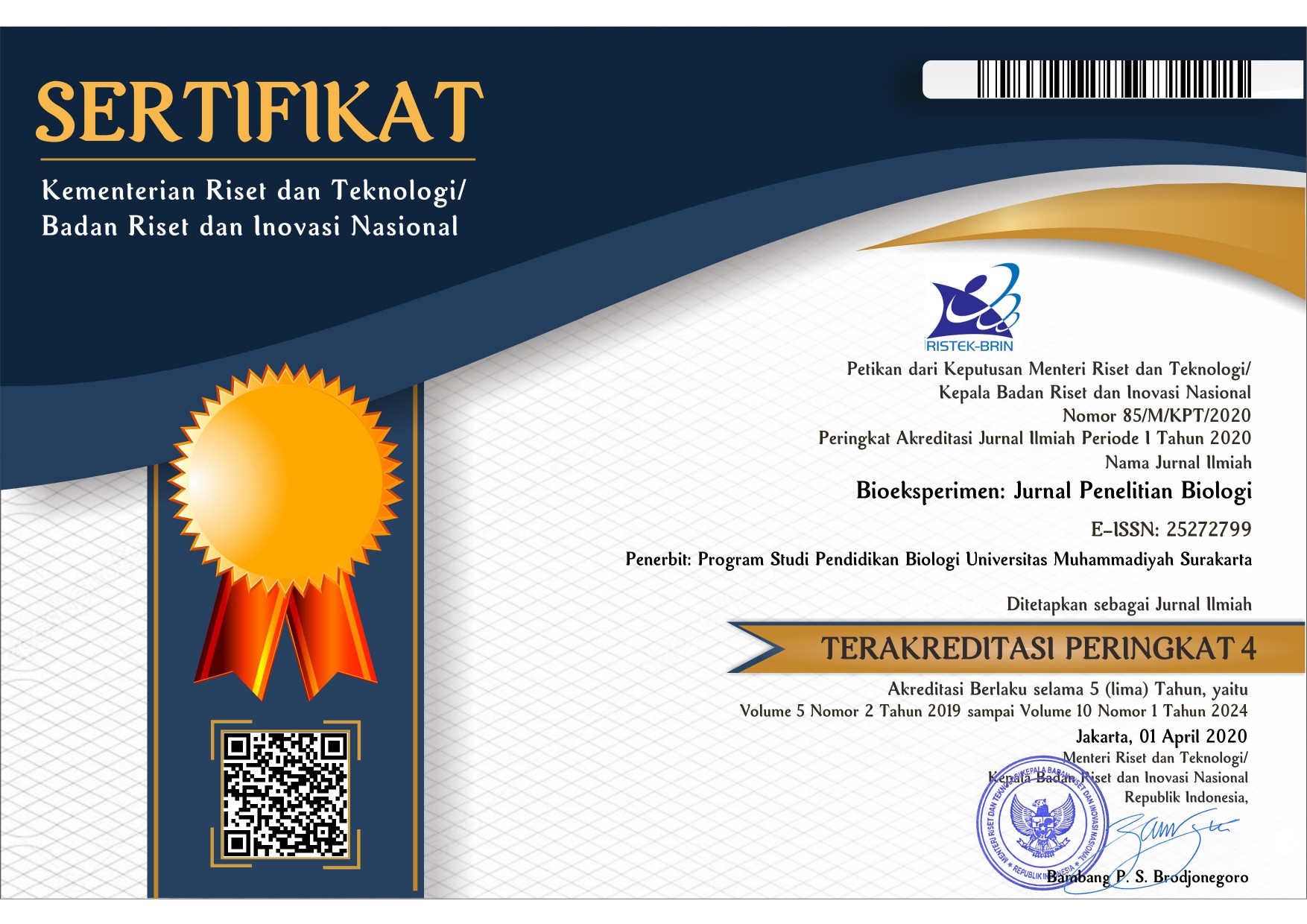Fitoremediasi Logam Kromium di Tanah Sawah dengan Rami (Boehmeria nivea) dan Environmental Health Agriculture System (EHAS)
Alfian Chrisna Aji(1*), Mohammad Masykuri(2), Retno Rosariastuti(3)(1) Pascasarjana, Ilmu Lingkungan, Universitas Sebelas Maret
(2) Fakultas Keguruan dan Ilmu Pendidikan Universitas Sebelas Maret
(3) Fakultas Pertanian, Universitas Sebelas Maret
(*) Corresponding Author
Abstract
Keywords
Full Text:
PDFReferences
Aji, A.C., Masykuri, M., Rosariastuti, R. (2017). Phytoremediation of rice field contaminated by chromium with mendong (Fimbristylis globulosa) to supporting sustainable agriculture. Proceeding. The 3rd International Indonesian Forum for Asian Studies. Borderless Communities & Nation with Borders Challenges of Globalisation. 1236-1247.
Arnstein. (1969). Social Participation Scale. Minneapolis, University of Minnesota Press.
Balai Penelitian Tanah. (2009). Analisis kimia Tanah, Tanaman, Air, dan Pupuk: Petunjuk Teknis Edisi 2. Balai Penelitian Tanah: Bogor.
Banks, M.K., Schwab, A.P., Henderson, C. (2006). Leaching and reduction of chromium in soil as affected by soil organic content and plants. Chemosphere. 62, 255-264.
Budiastuti, S. (2010). Ekologi Umum: Teori Dasar Pengelolaan Lingkungan. UNS Press: Surakarta.
Do Nascimento, C.W.A., Xing, B. (2006). Phytoextraction: A review on enhanced metal availability and plant accumulation. Sciencta Agricola. 63, 299-311.
Dogo, S., Razic, S., Manojlovic, D., Slavkovic, L. (2011). Analysis of the bioavailability of Cr (III) and Cr (VI) based on the determination of chromium in Mentha piperita by graphite furnace atomic absorption spectrometry. Journal of the Serbian Chemical Society. 76, 143-153.
Dong, J., Wu, F., Huang R., Zang, G. (2007). A chromium-tolerant plant growing in Cr contaminated land. International Journal of Phytoremediation. 9, 167-179.
Eastmond, D.A., MacGregor, J.T., Slesinki, R.S. (2008). Trivalent Chromium: Assessing the genotoxic risk of an essential trace element and widely used human and animal nutritional supplement. Critical Reviews in Toxicology. 28, 173-190.
Ghosh, M., Singh, S.P. (2005). A review on phytoremediation of heavy metals and utilization of its by products. Asian Journal on Energy and Environment. 3, 214-231.
Glick, B.R. (2010). Using soil bacteria to facilitate phytoremediation. Biotechnology Advances. 28, 367-374.
Han, F.X., Yi Su, Sridhar, M.B.B., Monts, D.L. (2004). Distribution, transformation and bioavailability of trivalent and hexavalent chromium in contaminated soil. Plant and Soil. 265, 243-252.
Han, R., Geller, J.T., Yang, L., Brodie, E.L., Chakraborty, R., Larsen, J.T., Beller, H.R. (2010). Physiological and transcriptional studies of Cr (VI) reduction under aerobic and denitrifying conditions by aquifer-derived Pseudomonad. Environmental Science and Technology. 44, 7491-7497.
Keraf, A.S. (2002). Etika Lingkungan. Kompas Media Nusantara: Jakarta.
Khan, M.S., Zaidi, A., Wani, P.A., Oves, M. (2009). Role of plant growth promoting rhizobacteria in the remediation of metal contaminated soils, Environmental Chemistry Letters. 7, 1-19.
Kidd, P., Barcelo, J., Bernal, M.P., Navari-Izzo, F., Poschenrieder, C., Shilev, S., Clemente, R., Monterroso, C. (2009). Trace element behaviour at the root–soil interface: Implications in phytoremediation. Environmental and Experimental Botany. 67, 243-259.
Ma, Y., Prasad, M.N.V., Rajkumar, M., Freitas, H. (2011). Plant growth promoting rhizobacteria and endophytes accelerate phytoremediation of metalliferous soils. Biotechnology Advances. 29, 248–258.
Mangkoedihardjo, S., Ratnawati, R., Alfianti, N. (2008). Phytoremediation of hexavalent chromium polluted soil using Pterocarpus indicus and Jatropha curcas L. World Applied Sciences Journal. 4, 338-342.
Owlad, M., Aroua, M.K., Daud, W.A.W., Baroutian, S. (2009). Removal of hexavalent chromium-contaminated water and wastewater: A review. Water, Air, and Soil Pollution. 200, 59-77.
Peraturan Pemerintah Republik Indonesia Nomor 101 Tahun 2014 tentang Pengelolaan Limbah Bahan Berbahaya dan Beracun.
Pramono, A., Rosariastuti, R., Ngadiman, Prijambada, I.D. (2012). Peran rhizobakteria dalam fitoekstrasi logam berat kromium pada tanaman jagung. Ecolab. 6, 38-50.
Purwati, R.D. 2010. Strategi Pengembangan Rami (Boehmeria nivea Gaud.). Perspektif. 9, 106-118.
Rajkumar, M., Ae, N., Prasad, M.N.V., Freitas, H. (2010) Potential of siderophore-producing bacteria for improving heavy metal phytoextraction. Trends in Biotechnology. 28, 142-149.
Rosariastuti, R., Prijambada, I.D., Ngadiman, Prawidyarini, G.S., Putri, A.R. (2013). Isolation and identification of plant growth promoting and chromium uptake enhancing bacteria from soil contaminated by leather tanning industrial waste. Journal of Basic and Applied Sciences. 9, 243-251.
Sessitsch, A., Kuffner, M., Kidd, P., Vangronsveld, J., Wenzel, W.W., Fallmann, K., Puschenreiter, M. (2013). The role of plant-associated bacteria in the mobilization and phytoextraction of trace elements in contaminated soils. Soil Biology and Biochemistry. 60, 182-194.
Setyorini, D., Soeparto, Sulaeman. (2003). Kadar logam berat dalam pupuk. Prosiding Seminar Nasional Peningkatan Kualitas Lingkungan dan Produk Pertanian: Pertanian produktif ramah lingkungan mendukung ketahanan dan keamanan pangan. Pusat penelitian dan Pengembangan Tanah dan Agroklimat, badan Penelitian dan Pengembangan Pertanian, Jakarta. 219-229.
Shanker, A.K., Cervantes, C., Loza-Tavera, H., Avudainayagam, S. (2005). Chromium toxicity in plants. Environmental. International. 31, 739-753.
Singani, A.A.S., Ahmadi, P. (2012). Manure application and cannabis cultivation influence on speciation of lead and cadmium by selective sequential extraction. Soil Sediment Contam. 21, 305-321.
Singh, J.S., Kuffner, M., Singh, D.P. (2011). Efficient soil microorganism: A review dimension for sustainable agriculture and environmental development. Agriculture, Ecosystem, & Environment. 140, 339-353.
Suntoro. (2010). Manajemen Sumber Daya Lahan Ramah Lingkungan. UNS Press: Surakarta.
Susarla, S., Medina, V.F., McCutcheon S.C. (2002). Phytoremediation: An ecological solution to organic chemical contamination. Ecological Engineering. 18, 647-658.
Tahmasbian, I., Singani, A.A.S. (2014). Chelate-assisted phytoextraction of cadmium from a mine soil by negatively charged sunflower. International Journal Environmental Science and Technology. 11, 695-702.
Undang Undang Republik Indonesia Nomor 32 Tahun 2009 Tentang Perlindungan dan Pengelolaan Lingkungan Hidup.
Uroz S., Calvaruso, C., Turpault, M.P., Frey-Klett, P. (2009). Mineral weathering by bacteria: ecology, actors and mechanisms. Trends in Microbiology. 17, 378-387.
Wenzel, W.W. (2009). Rhizosphere processes and management in plant-assisted bioremediation (phytoremediation) of soils. Plant and Soil. 321, 385-408.
Article Metrics
Abstract view(s): 1314 time(s)PDF: 1336 time(s)
Refbacks
- There are currently no refbacks.








